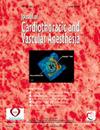Perioperative Stroke Following Implantation of Left Ventricular Assist Device: A Retrospective Cohort Study
IF 2.3
4区 医学
Q2 ANESTHESIOLOGY
Journal of cardiothoracic and vascular anesthesia
Pub Date : 2025-02-01
DOI:10.1053/j.jvca.2024.11.025
引用次数: 0
Abstract
Objectives
Stroke is common following left ventricular assist device (LVAD) implantation, although comprehensive data on perioperative strokes in this uncommon population is lacking. The current study aim was to characterize the presentation, features, and outcomes of perioperative cerebrovascular ischemia post-LVAD implantation at the authors’ institution.
Design
Single-center retrospective cohort.
Setting
St. Paul's Hospital, Vancouver, British Columbia, Canada.
Participants
Adult patients who received an LVAD between January 1, 2008, and August 31, 2021, were included, and those who died intraoperatively or underwent a concurrent cardiac surgical procedure were excluded.
Interventions
Data on demographics, comorbidities, stroke risk factors and characteristics, management, and outcomes (transplant, explant, death with LVAD in situ) were extracted.
Measurements and Main Results
After exclusions, 172 adult patients who underwent LVAD implantation during the study period were included and analyzed. The rate of perioperative stroke was 12.8% (22/172). Of these, 72.7% (16/22) had a stroke occur within 7 days of surgery, and 86.4% (19/22) had a primarily ischemic (v hemorrhagic) event. A total of 68.2% (15/22) were intubated, sedated, or recently extubated at symptom onset, complicating diagnosis. All were managed supportively or palliated without specific stroke intervention. Patients who experienced a perioperative stroke had a significantly lower cumulative incidence of survival to cardiac transplantation and a significantly higher cumulative incidence of dying with their device in situ.
Conclusions
LVAD patients carry a high risk of perioperative stroke. They experience delayed recognition and diagnosis, limited intervention, and poor outcomes. Frequent neurological assessment and a low threshold for neuroimaging are prudent.
植入左心室辅助装置后围手术期卒中:一项回顾性队列研究。
目的:左心室辅助装置(LVAD)植入后卒中是常见的,尽管缺乏这一罕见人群围手术期卒中的综合数据。目前的研究目的是描述作者所在机构lvad植入后围手术期脑血管缺血的表现、特征和结果。设计:单中心回顾性队列。地点:加拿大不列颠哥伦比亚省温哥华圣保罗医院。参与者:纳入2008年1月1日至2021年8月31日期间接受LVAD的成年患者,排除术中死亡或同时接受心脏外科手术的患者。干预措施:提取了人口统计学、合并症、卒中危险因素和特征、管理和结果(移植、外植体、原位LVAD死亡)的数据。测量和主要结果:排除后,172例在研究期间接受LVAD植入的成年患者被纳入并分析。围手术期卒中发生率为12.8%(22/172)。其中,72.7%(16/22)的患者在手术后7天内发生中风,86.4%(19/22)的患者主要发生缺血性(出血性)事件。共有68.2%(15/22)的患者在症状发作时插管、镇静或最近拔管,使诊断复杂化。所有的治疗都是支持性的或缓和的,没有特定的卒中干预。围手术期卒中患者的心脏移植累积生存率明显较低,而心脏移植装置原位死亡的累积发生率明显较高。结论:LVAD患者围手术期卒中风险较高。他们的认识和诊断延迟,干预有限,结果不佳。频繁的神经学评估和较低的神经影像学阈值是谨慎的。
本文章由计算机程序翻译,如有差异,请以英文原文为准。
求助全文
约1分钟内获得全文
求助全文
来源期刊
CiteScore
4.80
自引率
17.90%
发文量
606
审稿时长
37 days
期刊介绍:
The Journal of Cardiothoracic and Vascular Anesthesia is primarily aimed at anesthesiologists who deal with patients undergoing cardiac, thoracic or vascular surgical procedures. JCVA features a multidisciplinary approach, with contributions from cardiac, vascular and thoracic surgeons, cardiologists, and other related specialists. Emphasis is placed on rapid publication of clinically relevant material.

 求助内容:
求助内容: 应助结果提醒方式:
应助结果提醒方式:


